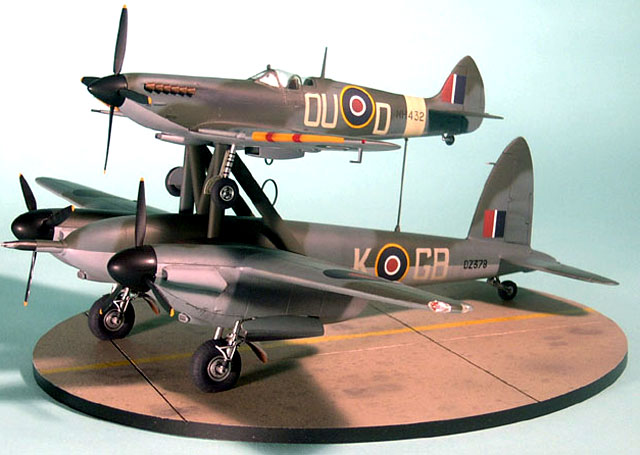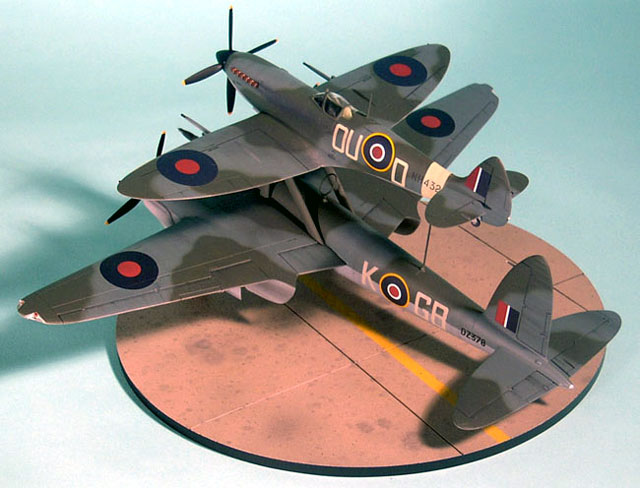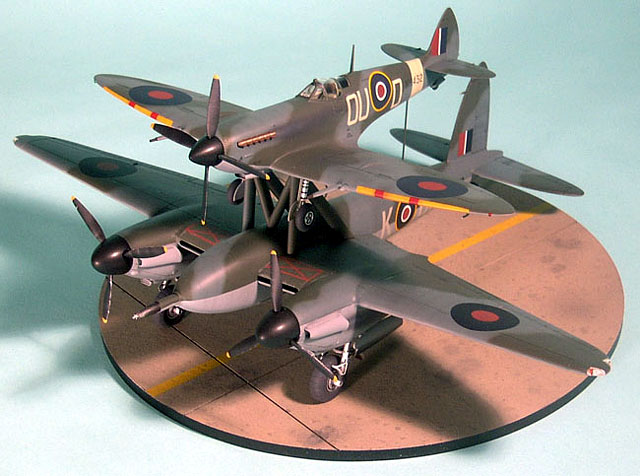|
Mistletoe
Mosquito/Spitfire Composite
by Tory Mucaro
|

|
|
Mistletoe
Mosquito/Spitfire Composite |
(Now
you do realise this is a hoax, don't you?)

HyperScale is proudly supported by
Squadron.com
The Mistletoe series of composite aircraft are without a doubt one of
the strangest concepts to nearly achieve operational status with the
RAF.
Geoffrey DeHavilland Jr., the Mosquito’s original test pilot,
proposed the concept to the Air Ministry in 1942. His idea was to make
use of "tired" DH 98 airframes by packing them with explosives, fly them
near a target and crash them into the target after the Spitfire parasite
fighter had released itself. The Spitfire pilot would then guide the
"missile" after release via remote control.

The first conversion flew in July 1943 and proved successful enough
for the RAF to approved a further 15 conversions, under the code name
“Mozart”. However, further testing of DH98 airframes fitted with hollow
charge warheads revealed a serious deficiency, which more often than not
resulted in the destruction of the airframe without detonation of the
explosives.
Testing also revealed that the Mosquito’s lightweight wooden airframe
did not have the penetrating power hoped for against heavily fortified
targets. Under service conditions, this would have resulted in
inflicting little more than an extensive scattering of splinters on
enemy personal.

All this, coupled with the high demand for Merlin engines needed for
remanufacture at the time brought the project to an abrupt end in March
of 1944.
So by now you all must have realized that this weapon never existed
outside of the moss-encrusted catacombs of my mind.
It came about as a result of a group build based on Monogram's
venerable 1/48 Mosquito kit. Never satisfied to just build the damn
thing as it was meant to be, I decided to desecrate one of the most
hallowed aircraft of all time by turning it into little more than a
flying bomb. So to all of you purists out there screaming “Sacrilege!”
my most sincere apologies.
As I mentioned, the Mosquito “Bomb” was converted from the Monogram
kit. The fighter nose was used and the cockpit area filled with styrene
sheet and Milliput two-part epoxy. The detonator probe is a 1/72 bomb
from a MiG-21 kit and some Evergreen telescoping tubing. The fighter
support structure is K&S brass airfoil tubing cut to length and soldered
together. The radio control receiver antenna is formed and soldered
brass wire. It was finished with Model Master enamels and weathered with
Floquil Grimy Black and a silver Prismacolor pencil. The kit decals were
used.

The Spitfire Mk. VIII is the Otaki kit, built pretty much straight
from the box with the exception of the radio control transmitter antenna
added to the bottom, fashioned from formed and soldered brass wire. It
was finished the same as the Mosquito, but the decals are from an Eagle
Strike sheet.
The base is a piece of .250-inch thick styrene sheet scribed and
painted with Polly S Old Concrete and then heavily weathered with a
variety of paint.
Hope you all enjoyed it!
Click on the thumbnails
below to view larger images:
Model, Images and Text Copyright © 2004 by
Tory Mucaro
Page Created 18 January, 2004
Last Updated 17 March, 2004
Back to HyperScale
Main Page
|
Home |
What's New |
Features |
Gallery |
Reviews |
Reference |
Forum |
Search